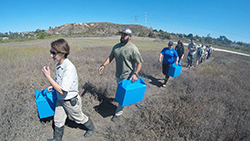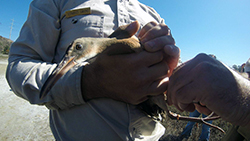
Staff of several wildlife agencies carry light-footed Ridgway’s rails (previously known as light-footed clapper rails) to Batiquitos Lagoon Ecological Reserve.

A light-footed Ridgway’s rail is banded before release into Batiquitos Lagoon Ecological Reserve.
The Ridgway’s rail is a grayish-brown, chicken-sized bird with a long, downward curving bill and a conspicuous whitish rump. Previously known as the clapper rail, the species name was changed in 2014 to honor ornithologist Robert Ridgway. Three subspecies of Ridgway’s rail are resident in California, all of which depend on mudflats or very shallow water (wetland habitat) where there is both forage and taller plant material to provide cover at high tide. They rely on marsh plants such as cordgrass and pickleweed for breeding and feeding.
One subspecies, the light-footed Ridgway’s rail, was once abundant in the Southern California wetlands, but fell to near extinction in the 1980s as their historical habitats were displaced by housing developments. Today, they have a chance to repopulate, buoyed by recent wetland restoration projects by the California Department of Fish and Wildlife (CDFW) and “Team Rail,” a group that has been dedicated to the recovery of this federal- and state-listed marsh bird for more than a decade.
Team Rail is comprised of scientific staff from CDFW, the U.S. Fish and Wildlife Service (USFWS), the U.S. Navy, three zoological breeding centers (SeaWorld San Diego, the San Diego Zoo Safari Park, and the Living Coast Discovery Center) and the Huntington Beach Wetlands Conservancy. Thanks to their efforts, the 2017 rail population reached 514 pairs in the wild. Each rail release is a step closer to achieving the 1985 Light-Footed Clapper Rail Recovery Plan objective of having 800 breeding pairs in California.
Most recently, five light-footed Ridgway’s rails were released into the Batiquitos Lagoon Ecological Reserve in San Diego County. This release consisted of two mated pairs and three offspring produced by one of the pairs. Three of the adults are retired breeders from the zoological breeding program and are part of a rotation plan to reintroduce retired breeders back into the wild. The release of these individuals will contribute genetic diversity to this highly endangered marsh bird population. Rails bred in zoological facilities were released into Batiquitos Lagoon in 2004 and 2005 (eight rails each year), in 2013 (six rails), 2014 (12 rails), and 2015 (seven rails).
“Given that State Ecological Reserves are set aside for the conservation of threatened, rare and endangered species, and rail releases are targeted for wetlands with small subpopulations (fewer than 50 breeding pairs), Batiquitos Lagoon is an ideal location for the release of Ridgway’s rails,” explained CDFW Senior Environmental Scientist (Specialist) Nancy Frost. “For over a decade, CDFW has supported numerous research and monitoring projects for this species, and we are proud to be a partner in their recovery.”
The state-owned Batiquitos Lagoon is managed by CDFW and is one of the few remaining tidal wetlands on the Southern California coast. Located in the city of Carlsbad, it consists of 543 acres with a drainage basin of about 55,000 acres. It is home to several threatened and endangered birds, insects, plants, fish and mammals and is also designated as a State Marine Conservation Area under the Marine Life Protection Act.
Top photo: A light-footed Ridgway’s rail flies away after being released at Batiquitos Lagoon Ecological Reserve in San Diego County.